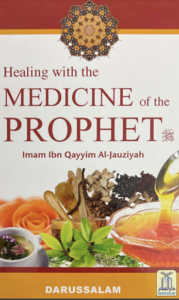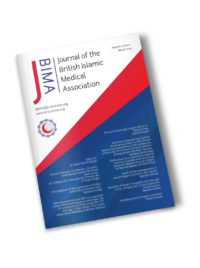
Written in the fourteenth century, ‘Healing with the Medicine of the Prophet (pbuh)’ is a veritable encyclopaedia of prophetic medicine. The book seeks to compile the Prophet’s (pbuh) guidance regarding various health issues. From specific cures and treatments to the prophetic etiquette of eating and drinking to guidance on enforcing quarantine, it is evident that such guidance continues to be highly beneficial and relevant to Muslims and non-Muslims alike.
Before proceeding with the review, it is incumbent upon us to place the text in its historical context and offer up numerous important caveats.
The text was written over 650 years ago by Imam Ibn Qayyim Al-Jauziyah, a student of Ibn Taymiyyah. He was an important medieval Islamic theologian and jurisprudent with an extensive contribution to Islamic jurisprudence and commentaries. The book has since been translated from Arabic into English by Imam Jalal Abualrub. The usual caveats are as follows.
First, much is lost in translation when a medieval Islamic text is translated for a modern audience. Translation is a difficult science in and of itself. At times, the book has translated a hadith or saying in such a manner that may open debate as to whether the meaning has been correctly conveyed.
Second, as a medieval text, this book does not have the traditional sectioning or narrative as one would imagine. Rather than a contents, one should refer to the comprehensive index at the end of the book which lists the different sections.
In light of these caveats, and the length of the book reaching 653 pages, this review will merely pick out the most interesting and useful guidance presented. The final section of the review will seek to further contextualise certain sections and emphasise the importance of contextual cues in studying the Quran and sunnah.
Specific Prophetic Guidance
For all sections, Ibn Qayyim Al-Jauziyah follows a useful structure. First, he lists the scriptural evidence supporting a particular treatment. Drawing from the Quran, sunnah and contemporaries of the time, Ibn Qayyim Al-Jauziyah seeks to bolster the evidential basis. Second, he explains the benefits of a specific treatment or food from his understanding at the time of writing. This includes the reasoning behind the advice, techniques and further advice.
Cupping
Cupping is a well-known treatment advocated by the Prophet (pbuh). Ibn Qayyim Al-Jauziyah compiles a number of hadiths advising the use of cupping as a remedy and a preventative treatment. He further elaborates on the technique and where to perform the cupping to target different types of ailments. The sheer versatility of cupping is evidenced by his explanation that all such ailments may be treated including ailments of the head, face, teeth, ears, eyes, nose, throat, swellings, headaches and general body pains. Modern scientific research confirms what Ibn Qayyim Al-Jauziyah recorded more than 650 years ago, with research emerging that cupping really does produce all manner of effects including pain relief, anti-inflammatory, immunomodulation and detox effects.
Sleep
The book discusses the prophetic guidance regarding sleep routines and positions. The prophetic advice of sleeping on the right side is discussed and the science behind this is further explained. Interestingly, Ibn Qayyim Al-Jauziyah records that “sleeping on the left side regularly harms the heart because the organs of the body will pressure the heart with their weight” and that one of the worst positions is sleeping on one’s back and stomach.
Research shows that people suffering from heart failure naturally sleep on their right side and avoid sleeping on their left side. Their echocardiograms show that sleeping on their left side impacts the function of the heart and may cause discomfort[1]. While experts are unanimous that sleeping on one’s stomach causes back pain because the position does not support the curve of the spine.
Mental health and bedside manner
The book records the hadith of the Prophet (pbuh) stating that “when you visit a sick person, say good words to him, for the sake of Allah for although that does not prevent any harm, it still brings relief to the patient’s heart” (Al Tirmidhi).
Ibn Qayyim Al-Jauziyah explains that this hadith contains “one of the most honourable remedies, that is, relieving the anxiety of the sick with some good words that will enhance his resolve and strength”. He explains the link of relieving the anxiety of a sick person to curing the body and lessening the effects of an ailment. The book also records the hadith of the Prophet asking a sick person what he has a taste for and following this by advising “when yours sick have a taste for something, give them some of it”.
The book’s emphasis on the Prophet’s compassion towards the ill and his awareness of the link between mental and physical health is particularly enlightening from a Western medicine perspective. The link between physical and mental health has only emerged within western medicine over the past few decades. While the drive behind good bedside manner is relatively new; British doctors may be aware of Dr Kate Granger’s laudable “hello my name is” campaign for compassionate care and basic communication[2]. In light of this, it is especially interesting to observe how prophetic medicine explains how one’s bedside manner affects a patient’s mental and physical health.
Specific foods
From page 359 onwards, an alphabetical listing of specific foods begins. This section is particularly enlightening for the reader looking for prophetic guidance on specific foods. The following is a brief overview of the most discussed foodstuff:
Black seed oil: the widely cited hadith concerning black seed oil being a cure for every type of ailment except death is quoted. The book also advises specific mixtures and applications depending on the type of ailment. Such commentary is especially useful in understanding just how comprehensive medieval Islamic medicine was.
Figs: Imam Ibn Qayyim Al-Jauziyah notes that figs help with liver and prostate health and that they relieve the “roughness in the chest, throat and trachea”. Modern evidence supports these comments.[3]
Fenugreek: the book records a hadith where the prophet advised an ill person to take fenugreek. Once again, Ibn Qayyim Al-Jauziyah notes specific mixtures and applications depending on the type of ailment. He specifies that it helps relieve coughing, drying, asthma, dandruff and other matters.
Conclusion
A number of observations will follow:
First, this book is truly a panacea for all such ailments, incorporating alternative and traditional medicine. The reader should begin by flicking through the index and glancing through the alphabetical listing of specific foodstuff. The reader will find it difficult to find a herb which will not target a specific ailment. Interestingly, most explanations and treatments mentioned by Ibn Qayyim Al-Jauziyah can be supported by modern research.
Second, the book perfectly captures the beauty of the Islamic tradition. In all aspects of our lives, prophetic guidance emphasises that one must pray and trust the Divine plan whilst also taking action. As the oft-cited hadith goes, one must ‘tie one’s camel’ and then trust Allah, meaning that one must take active action while also relying on God’s plan. This applies within the medical setting. For each section, the book reports specific prayers one may recite for an ailment, and this is followed by the actions one must take. Moreover, the book cites the prophetic guidance on seeking the best doctors and requiring compensation from those unqualified to practice medicine. Such advice merely evidences that Islam is a way of life and takes a holistic approach in adopting both alternative and traditional medicine.
Third, this 653-page book has a limited aim of conveying the prophetic medicine. It does not aim to analyse the fiqh or explanations behind specific hadiths or Quranic verses. At times, Ibn Qayyim Al-Jauziyah does not mention the specific context behind a hadith and extracts a rule from the hadith. As we know, context is absolutely vital when reading hadiths and interpretations of hadiths vary. The reader should keep this in mind. Ibn Qayyim Al-Jauziyah’s interpretation is only one of many. One must also be reminded that this is a medieval text and certain sections may be seen as controversial from a modern perspective.
Fourth, to obtain the benefits from this book, one must retain an open mind. As aforementioned, occasionally the text does not translate well into English. Moreover, the modern medical vocabulary we have grown accustomed to is of course not present in a medieval text. Therefore, at times, one may read a section of Ibn Qayyim Al-Jauziyah’s explanation of how a specific substance benefits the body and consider that this may be an ‘old wives’ tale’ or merely a myth because of the simplicity of language. However, once one researches the benefits of a specific foodstuff or treatment, one will discover that the explanation offered in modern research adheres to Ibn Qayyim Al-Jauziyah’s explanation from 650 years ago.
An important lesson emerges from this. As doctors in the West, we can often look down on ancient remedies or alternative medicine techniques as inferior to Western medicine and merely ‘old wives’ tale’. This book serves as a constant reminder that we are often catching up to the knowledge of our Islamic tradition and its teachers, the best of which was the Prophet (pbuh).
[1]Leung RS, Bowman ME, Parker JD, Newton GE, Bradley TD. Avoidance of the left lateral decubitus position during sleep in patients with heart failure: relationship to cardiac size and function. J Am CollCardiol. 2003 Jan 15;41(2):227-30. doi: 10.1016/s0735-1097(02)02717-1. PMID: 12535814.
[2]https://www.hellomynameis.org.uk
[3]Mawa S, Husain K, Jantan I. Ficuscarica L. (Moraceae): Phytochemistry, Traditional Uses and Biological Activities. Evid Based Complement Alternat Med. 2013;2013:974256. doi:10.1155/2013/974256


